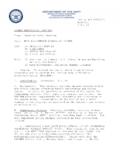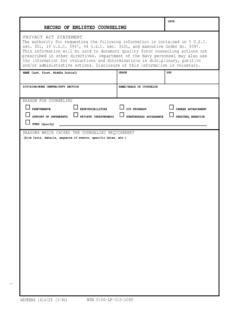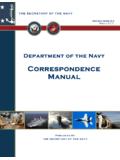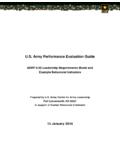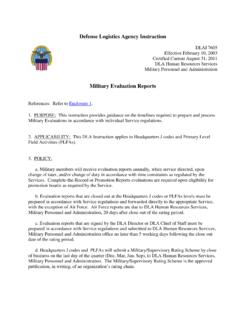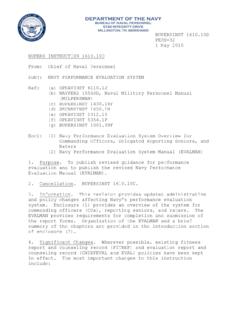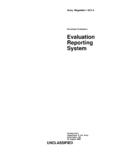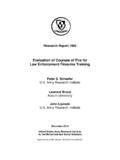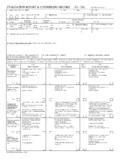Transcription of BUPERSINST 1610.10C Ref: (a) OPNAVINST 6110.1H …
1 BUPERSINST PERS-32. 20 APR 2011. BUPERS INSTRUCTION From: Chief of Naval Personnel Subj: NAVY performance evaluation SYSTEM. Ref: (a) OPNAVINST (b) MILPERSMAN. (c) BUPERSINST (d) SECNAVINST Encl: (1) Overview for Commanding Officers, Delegated Reporting Seniors, and Raters (2) Navy performance evaluation Manual (EVALMAN). 1. Purpose. To publish revised guidance in performance evaluation and to publish the revised Navy performance evaluation Manual (EVALMAN). 2. Cancellation. BUPERSINST 3. Information. This revision provides updated administrative and policy changes affecting Navy's performance evaluation system. Enclosure (1) provides an overview of the system for commanding officers (COs), reporting seniors, and raters. The EVALMAN provides requirements for completion and submission of the report forms. Organization of the EVALMAN and a brief summary of the chapters are provided in the Introduction section of enclosure (2).
2 4. Significant Changes. Wherever possible, existing Fitness Report and Counseling Record (FITREP) and evaluation Report and Counseling Record (EVAL) policies have been kept in effect. The most important policy changes contained in this instruction include: a. Revising how Physical Fitness Assessment (PFA) results are documented on performance evaluations. All performance evaluations submitted with an end date (block 15) of 1 August 2010 or later must comply with the new policy. The new policy BUPERSINST 20 APR 2011. introduces a single letter code to represent the result of each official PFA conducted during a reporting period. b. Introducing a new billet subcategory (Block 21) code to breakout active duty personnel who are performing an Individual Augmentation Manpower Management (IAMM) assignment, Global Support Assignment (GSA) or Overseas Contingency Operation Support Assignment (OSA).
3 Regular reporting seniors may begin using this code for performance evaluations submitted with an end date (block 15) of 1 August 2010 or later. The new billet subcategory does not apply to flag officers. c. Incorporating NAVADMIN 22/10 guidance for the final disposition of rejected Navy performance evaluation system reports. d. Clarifying the use of SELECTED as a promotion status in block 8. Enlisted personnel selected to commissioning programs that would make them ineligible for the E7-E9 selection boards ( , LDO/CWO in-service or Flying CWO programs) may use the SELECTED promotion status. However, personnel selected to other commissioning programs (Seaman to Admiral, Medical Enlisted Commissioning program, and Medical Service Corps In- Service Procurement program) remain eligible for the E7-E9. selection board and may not use this promotion status. e. Allowing the use of a Special report upon completion of Medical Postgraduate Internship program and Medical Resident/Fellow Graduate program when officers have follow-on permanent change of station (PCS) orders to the same medical facility upon graduation.
4 F. Allowing Concurrent reporting seniors to do Special reports. See chapter 4 for situations where a Concurrent Special report is authorized. g. Permitting a Navy Reserve Unit CO to do concurrent reports for Selected Reserve (SELRES) members assigned to the unit in a Cross Assigned-In (CAI) status. h. Incorporating NAVADMIN 206/10 concerning the Information Dominance Corps (IDC) realignment (18xx series) effective 1 October 2010. 2. BUPERSINST 20 APR 2011. i. Incorporating the Permanent Military Professor (123X) as an officer competitive category. j. Changing the combined early and must promote upper limit promotion recommendations to 60 percent for E5s effective 15. March 2011. k. Removing Message Summary Reports. l. Making it mandatory to document in the evaluative comments (block 41 on FITREP/CHIEFEVAL and block 43 on EVAL). concluded Judicial or Non-Judicial Punishment (NJP) where there has been a finding of guilty or award of punishment.
5 5. Change Recommendations. FITREP, chief petty officer evaluations (CHIEFEVAL) and EVAL policies, procedures, and requirements may be modified only by change to this instruction. Submit recommendations to Navy Personnel Command (NAVPERSCOM), performance Evaluations Division (PERS-32). 6. Records Management. Records created as a result of this instruction, regardless of media and format, shall be managed per Secretary of the Navy Manual of November 2007. 7. Forms a. The following forms may be obtained using requisitioning procedures contained in Naval Forms Online at (1) NAVPERS 1610/2 (8/10) Fitness Report and Counseling Record (W2-O6). (2) NAVPERS 1616/26 (8/10) evaluation Report and Counseling Record (E1-E6). (3) OPNAV 5239/14 (07/08) System Authorization Access Request-Navy. b. NAVPERS 1610/4 (7-95) Request for performance Summary Record is available in the Bureau of Naval Personnel (BUPERS).
6 CD-ROM. 3. BUPERSINST 161 0 .10C. 20 APR 201 1. c . Following forms are available through the Office of the Chief of Naval Operations (OPNAV) (NOOF) I Flag Matters at ( 703). 614-1129 / DSN 224. (1 ) NAVPER$ 1610 / 5 (8 / 1 0) Fitness Report and Counseling Reco rd ( 0 7 -0 8) . (2) NAVPERS 1616 / 23 MEMORANDUM - Signature Authentication to accept Non CAe user FITREPS. d. NAVPERS 1616 / 27 (8-10), evaluation and Counseling Record ( E7 -E9) is available at http : //www .. mil/ReferenceLibrary/Fo r ms/ . e . DD 149 ( 5EP 07) Application for Correction o f Military Record Under the Provisions of 10 , 1552 is available at http : . htm. 8. Reports. Report Control Symbol BUPERS 1610 - 1 has been assigned to the reports required by paragraph 3 and is approved per Secretary of the Navy Manual of December 2005. <----J1I. f M. E. 1, Navy Distribution: Electronic only via BUPERS Web site http:/ / www.
7 / ReferenceLibrary / lnstructions / BUPERS lnst ruc tions ! 4. BUPERSINST 20 APR 2011. NAVY performance evaluation SYSTEM. OVERVIEW FOR. COMMANDING OFFICERS, DELEGATED REPORTING SENIORS, AND RATERS. Enclosure (1). BUPERSINST 20 APR 2011. 1. Purpose. This enclosure provides an overview of the Navy performance evaluation System. While each of the statements in this enclosure constitutes policy, specific actions may require the detailed instructions found in the EVALMAN, enclosure (2). 2. How Does the Report Work? The system utilizes a FITREP for officers (W2-O6), CHIEFEVAL for Chief Petty Officers (E7-E9) and an EVAL for other enlisted personnel (E1-E6). performance traits are graded on a 5-point scale, from (lowest) to (highest), using performance standards printed on the forms. The performance trait grade of represents performance to full Navy standards. Higher grades are reserved for performance which significantly exceeds standards.
8 All grades must be substantiated in the comments, as well as general comments on the remainder of the evaluative blocks. If there is a promotion recommendation of "Significant Problems," or any recommendation against retention, the report shall be treated as adverse. All forms provide a 5- step promotion recommendation scale: "Significant Problems,". "Progressing," "Promotable," "Must Promote," and "Early Promote.". "Early Promote" recommendations are based solely on performance , and do not require eligibility for early promotion. There are;. however, mandatory limits on the number of "Early Promote". recommendations. For pay grades O1 and O2 (with the exception of Limited Duty Officers), no promotion recommendation higher than Promotable is allowed. For the more senior officer and enlisted pay grades, there are also limits on "Must Promote". recommendations. These limits ensure a sufficient range of recommendations make the reports useful to the promotion system.
9 For enlisted personnel, the promotion recommendation is also the performance mark average for the report period. The recommendations are translated into marks of , , , , and , respectively, on the traditional grading scale. 3. Who Can Be a Reporting Senior? a. COs and officers in charge (OICs) are a reporting senior by virtue of their command authority. They may submit properly authorized FITREPs, CHIEFEVALs, and EVALs on any member who has reported to them for duty, whether junior or senior to them in grade. The term "commanding officer" is inclusive of all Services and their civilian equivalents within the Federal government. An OIC is a reporting senior if they are in charge of commissioned or established activities listed in the Standard Navy Distribution List. When a member is assigned to a 2 Enclosure (1). BUPERSINST 20 APR 2011. government activity, the reporting senior is the member's administrative commander unless another reporting senior is assigned by order or directive.
10 A member in this category may receive a letter-type report from the government activity for attachment to a FITREP, CHIEFEVAL, or EVAL. b. Delegation of reporting senior authority is an actual transfer of that authority, and not merely an authorization to sign "By direction." For this reason, delegation is held to the highest level consistent with effective observation of performance , and the CO's oversight responsibilities are carefully defined. For specific direction concerning delegated reporting seniors, refer to enclosure (2), chapter 2. c. An immediate superior in command (ISIC) is a reporting senior for assigned COs and is authorized to assume the reporting senior authority of a subordinate CO whose capacity to act as a reporting senior becomes impaired. Specific guidance is contained in enclosure (2), chapter 2. d. An enlisted OIC in the grade of E9 and civilians in command positions who hold the grade of GS-9 through GS-12 may sign reports on E5 and below.
